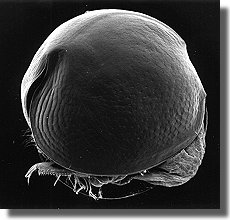Morphology
The Cladocera are relatively primitive crustaceans with their bodies completely enclosed by an uncalcified shell (or carapace) and having 9 or 10 pairs of appendages - antennules, antennae, maxillae and mandibles attached to the head, and five or six trunk limbs, which are using for feeding and respiration.
The abdomen ends with the postabdomen which has a series of denticles along the dorsal margin, lateral setae and a terminal pair of postabdominal claws. The unhinged shell is attached to the headshield. The headshield-shell junction constitute the ecdysial line, which spreads apart at molting. On the headshield of the chydorids (members of the Chydoridae) is a series of median pores and two minor pores, the configuration of which is characteristic of subfamilies and genera. The headshield and shell can be sculptured in various ways.
The Cladocera are larger than diatoms. They can range in size from 0.3mm to > 6mm.
All the species mature through a series of juvenile stages (or instars), gradually becoming larger at each molt - see lifecycle.
There are about 400 to 500 described species in the world.
Ephippia, mandibles, headshields, shells and postabdomens and their claws are commonly preserved quantitatively in lake sediments. Ephippia are commonly preserved as fossils as far back as the Oligocene and probably from the Cretaceous.
TAXONOMY | LIFECYCLE | ECOLOGY
